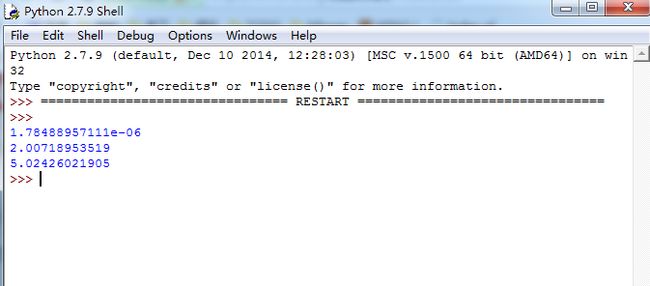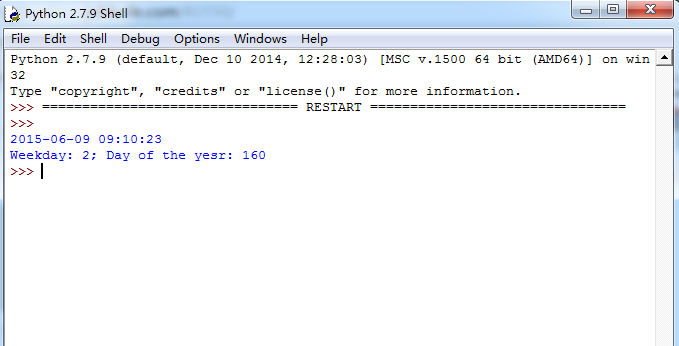Python模块学习笔记— —time与datatime
Python提供了多个内置模块用于操作日期时间。像calendar,time,datetime。首先对time模块中最经常使用的几个函数作一个介绍,它提供的接口与C标准库time.h基本一致。然后再介绍一下datatime模块,相比于time模块,datetime模块的接口则更直观、更easy调用。
time模块
time.time
time.time()函数返回从1970年1月1日以来的秒数,这是一个浮点数。
import time
print time.time()time.sleep
能够通过调用time.sleep来挂起当前的进程。time.sleep接收一个浮点型參数,參数单位为秒。表示进程挂起的时间。
time.clock
在windows操作系统上,time.clock() 返回第一次调用该方法到如今的秒数,其准确度高于1微秒。能够使用该函数来记录程序运行的时间。
import time
print time.clock()
time.sleep(2)
print time.clock()
time.sleep(3)
print time.clock()time.gmtime
该函数原型为:time.gmtime([sec]),可选的參数sec表示从1970-1-1以来的秒数。
其默认值为time.time(),函数返回time.struct_time类型的对象(struct_time是在time模块中定义的表示时间的对象)。
import time
print time.gmtime()
print time.gmtime(time.time() - 24 * 60 * 60) time.localtime
time.localtime与time.gmtime非常相似,也返回一个struct_time对象,能够把它看作是gmtime()的本地化版本号。
time.mktime
time.mktime运行与gmtime(), localtime()相反的操作。它接收struct_time对象作为參数。返回用秒数来表示时间的浮点数。
import time
print time.mktime(time.localtime())
print time.time()time.strftime
time.strftime将日期转换为字符串表示。它的函数原型为:time.strftime(format[, t])。參数format是格式字符串(格式字符串的知识能够參考:time.strftime)。可选的參数t是一个struct_time对象。
import time
print time.strftime('%Y-%m-%d %H:%M:%S', time.gmtime())
print time.strftime('Weekday: %w; Day of the yesr: %j')time.strptime
按指定格式解析一个表示时间的字符串,返回struct_time对象。
该函数原型为:time.strptime(string, format),两个參数都是字符串。
import time
print time.strptime('201-06-23 15:30:53', '%Y-%m-%d %H:%M:%S')以上不过time模块中最经常使用的几个方法,还有非常多其它的方法如:time.timezone, time.tzname …感兴趣的童鞋能够參考Python手冊 time 模块
datetime模块
datetime模块定义了两个常量:datetime.MINYEAR和datetime.MAXYEAR,分别表示datetime所能表示的最小、最大年份。
当中。MINYEAR = 1,MAXYEAR = 9999。
datetime模块定义了以下这几个类:
-datetime.date:表示日期的类。经常使用的属性有year, month, day。
-datetime.time:表示时间的类。经常使用的属性有hour, minute, second, microsecond;
-datetime.datetime:表示日期时间。
-datetime.timedelta:表示时间间隔。即两个时间点之间的长度。
-datetime.tzinfo:与时区有关的相关信息。(这里不具体充分讨论该类。感兴趣的童鞋能够參考python手冊)
【注】上面这些类型的对象都是不可变(immutable)的。
date类
date类表示一个日期。其构造函数例如以下:
class datetime.date(year, month, day)
year的范围是[MINYEAR, MAXYEAR],即[1, 9999];
month的范围是[1, 12]。
day的最大值依据给定的year, month參数来决定,闰年2月份有29天。
date类定义了一些经常使用的类方法与类属性。方便我们操作:
-date.max、date.min:date对象所能表示的最大、最小日期;
-date.resolution:date对象表示日期的最小单位。
这里是天。
-date.today():返回一个表示当前本地日期的date对象;
-date.fromtimestamp(timestamp):依据给定的时间戮。返回一个date对象。
-datetime.fromordinal(ordinal):将Gregorian日历时间转换为date对象;(Gregorian Calendar:一种日历表示方法,相似于我国的农历,西方国家使用比較多。)
from datetime import *
import time
print 'date.max:', date.max
print 'date.min:', date.min
print 'date.today():', date.today()
print 'date.fromtimestamp():', date.fromtimestamp(time.time())date提供的实例方法和属性:
-date.year、date.month、date.day:年、月、日;
-date.replace(year, month, day):生成一个新的日期对象,用參数指定的年,月,日取代原有对象中的属性。
-date.timetuple():返回日期相应的time.struct_time对象;
-date.toordinal():返回日期相应的Gregorian Calendar日期;
-date.weekday():返回weekday。假设是星期一,返回0。假设是星期2,返回1,以此类推;
-data.isoweekday():返回weekday,假设是星期一,返回1;假设是星期2,返回2,以此类推。
-date.isocalendar():返回格式如(year,month。day)的元组。
-date.isoformat():返回格式如’YYYY-MM-DD’的字符串;
-date.strftime(fmt):自己定义格式化字符串。
from datetime import *
now = date(2015,6,10)
tomorrow = now.replace(day = 11)
print 'now:',now, ', tomorrow:',tomorrow
print 'timetuple():', now.timetuple()
print 'weekday():', now.weekday()
print 'isoweekday():', now.isoweekday()
print 'isocalendar():', now.isocalendar()
print 'isoformat():', now.isoformat()date还对一些操作进行了重载,同意对日期进行例如以下一些操作:
-date2 = date1 + timedelta # 日期加上一个间隔,返回一个新的日期对象(timedelta将在以下介绍,表示时间间隔)
-date2 = date1 - timedelta # 日期隔去间隔,返回一个新的日期对象
-timedelta = date1 - date2 # 两个日期相减。返回一个时间间隔对象
date1 < date2 # 两个日期进行比較
【注】对日期进行操作时。要防止日期超出它所能表示的范围。
from datetime import *
now = date.today()
tomorrow = now.replace(day = 11)
delta = tomorrow - now
print 'now:', now, ' tomorrow:', tomorrow
print 'timedelta:', delta
print now + delta
print tomorrow > nowtime类
time类表示时间,由时、分、秒以及微秒组成。
time类的构造函数例如以下:
class datetime.time(hour[, minute[, second[, microsecond[, tzinfo]]]])
參数tzinfo表示时区信息。各參数的取值范围:hour的范围为[0, 24),minute的范围为[0, 60),second的范围为[0, 60)。microsecond的范围为[0, 1000000)。
time类定义的类属性:
-time.min、time.max:time类所能表示的最小、最大时间。当中time.min = time(0, 0, 0, 0)。 time.max = time(23, 59, 59, 999999);
-time.resolution:时间的最小单位。这里是1微秒;
time类提供的实例方法和属性:
-time.hour、time.minute、time.second、time.microsecond:时、分、秒、微秒。
-time.tzinfo:时区信息。
-time.replace([hour[, minute[, second[, microsecond[, tzinfo]]]]]):创建一个新的时间对象,用參数指定的时、分、秒、微秒取代原有对象中的属性(原有对象仍保持不变);
-time.isoformat():返回型如”HH:MM:SS”格式的字符串表示。
-time.strftime(fmt):返回自己定义格式化字符串。
from datetime import *
tm = time(7, 17, 10)
print 'tm:', tm
print 'hour: %d, minute: %d, second: %d, microsecond: %d' \
% (tm.hour, tm.minute, tm.second, tm.microsecond)
tm1 = tm.replace(hour = 8)
print 'tm1:', tm1
print 'isoformat():', tm.isoformat()像date一样,time也能够对两个time对象进行比較,或者相减返回一个时间间隔对象。
datetime类
datetime是date与time的结合体。包含date与time的全部信息。它的构造函数例如以下:
datetime.datetime(year, month, day[, hour[, minute[, second[, microsecond[, tzinfo]]]]])
各參数的含义与date、time的构造函数中的一样,要注意參数值的范围。
datetime类定义的类属性与方法:
-datetime.min、datetime.max:datetime所能表示的最小值与最大值;
-datetime.resolution:datetime最小单位;
-datetime.today():返回一个表示当前本地时间的datetime对象;
-datetime.now([tz]):返回一个表示当前本地时间的datetime对象,假设提供了參数tz,则获取tz參数所指时区的本地时间。
-datetime.utcnow():返回一个当前utc时间的datetime对象。
-datetime.fromtimestamp(timestamp[, tz]):依据时间戮创建一个datetime对象。參数tz指定时区信息。
-datetime.utcfromtimestamp(timestamp):依据时间戮创建一个datetime对象;
-datetime.combine(date, time):依据date和time,创建一个datetime对象;
-datetime.strptime(date_string, format):将格式字符串转换为datetime对象;
from datetime import *
import time
print 'datetime.max:', datetime.max
print 'datetime.min:', datetime.min
print 'datetime.resolution:', datetime.resolution
print 'today():', datetime.today()
print 'now():', datetime.now()
print 'utcnow():', datetime.utcnow()
print 'fromtimestamp(tmstmp):', datetime.fromtimestamp(time.time())
print 'utcfromtimestamp(tmstmp):', datetime.utcfromtimestamp(time.time())datetime类提供的实例方法与属性(非常多属性或方法在date和time中已经出现过,可參考上文):
-datetime.year、month、day、hour、minute、second、microsecond、tzinfo:
-datetime.date():获取date对象;
-datetime.time():获取time对象。
-datetime.replace([year[, month[, day[, hour[, minute[, second[, microsecond[, tzinfo]]]]]]]]):
-datetime.timetuple()
-datetime.utctimetuple()
-datetime.toordinal()
-datetime.weekday()
-datetime.isocalendar()
-datetime.isoformat([sep])
-datetime.ctime():返回一个日期时间的C格式字符串。等效于time.ctime(time.mktime(dt.timetuple()));
datetime.strftime(format)
像date一样。也能够对两个datetime对象进行比較,或者相减返回一个时间间隔对象。或者日期时间加上一个间隔返回一个新的日期时间对象。
格式字符串
datetime、date、time都提供了strftime()方法,该方法接收一个格式字符串。输出日期时间的字符串表示。
| 格式字符 | 意义 |
|---|---|
| %a | 星期的简写,如星期三为Web |
| %A | 星期的全写,如星期三为Wednesday |
| %b | 月份的简写,如4月份为Apr |
| %B | 月份的全写,如4月份为April |
| %c | 日期时间的字符串表示。(如: 04/07/10 10:43:39) |
| %d | 日在这个月中的天数(是这个月的第几天) |
| %f | 微秒(范围[0,999999]) |
| %H | 小时(24小时制。[0, 23]) |
| %I | 小时(12小时制,[0, 11]) |
| %j | 日在年中的天数 [001,366](是当年的第几天) |
| %m | 月份([01,12]) |
| %M | 分钟([00,59]) |
| %p | AM或者PM |
| %S | 秒(范围为[00,61]) |
| %U | 周在当年的周数当年的第几周),星期天作为周的第一天 |
| %w | 今天在这周的天数。范围为[0, 6],6表示星期天 |
| %W | 周在当年的周数(是当年的第几周),星期一作为周的第一天 |
| %x | 日期字符串(如:04/07/10) |
| %X | 时间字符串(如:10:43:39) |
| %y | 2个数字表示的年份 |
| %Y | 4个数字表示的年份 |
| %z | 与utc时间的间隔 (假设是本地时间,返回空字符串) |
| %Z | 时区名称(假设是本地时间。返回空字符串) |
| %% | %% => % |
from datetime import *
import time
dt = datetime.now()
print '(%Y-%m-%d %H:%M:%S %f): ', dt.strftime('%Y-%m-%d %H:%M:%S %f')
print '(%Y-%m-%d %H:%M:%S %p): ', dt.strftime('%y-%m-%d %I:%M:%S %p')
print '%%a: %s ' % dt.strftime('%a')
print '%%A: %s ' % dt.strftime('%A')
print '%%b: %s ' % dt.strftime('%b')
print '%%B: %s ' % dt.strftime('%B')
print '日期时间%%c: %s ' % dt.strftime('%c')
print '日期%%x:%s ' % dt.strftime('%x')
print '时间%%X:%s ' % dt.strftime('%X')
print '今天是这周的第%s天 ' % dt.strftime('%w')
print '今天是今年的第%s天 ' % dt.strftime('%j')
print '今周是今年的第%s周 ' % dt.strftime('%U')






